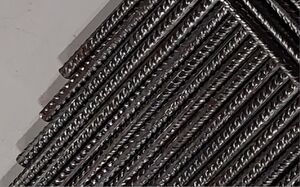Material:Steel: Difference between revisions
→Rebar: image |
infobox corrections |
||
| Line 9: | Line 9: | ||
|used with= | |used with= | ||
|contains= [[iron]], carbon | |contains= [[iron]], carbon | ||
|similar= | |similar=[[Stainless Steel|stainless steel]] | ||
}} | }} | ||
| Line 26: | Line 26: | ||
*Chemical: | *Chemical: | ||
**Corrosion resistance: How strong it rusts | **Corrosion resistance: How strong it rusts | ||
But not only the composition of the alloy but also the crystalline structure heavily influence the properties, just like coal and diamond (different structure and properties but both are carbon). The structure can be altered by the following processes: | But not only the composition of the alloy but also the crystalline structure heavily influence the properties, just like coal and diamond (different structure and properties but both are carbon). The structure can be altered by the following processes: | ||
*Heat treating | *Heat treating | ||
| Line 41: | Line 42: | ||
|donation= | |donation= | ||
|location= | |location= | ||
|tools | |tools=[[Disc Grinder|disc grinder]], [[Hacksaws|hacksaw]] | ||
|used with=[[concrete]] | |||
|contains=[[steel]] | |contains=[[steel]] | ||
|similar= | |similar= | ||
| Line 48: | Line 49: | ||
Rebar ('''re'''inforcing '''bar''') is a common steel product that is designed to reinforce [[concrete]] structures against tension. | Rebar ('''re'''inforcing '''bar''') is a common steel product that is designed to reinforce [[concrete]] structures against tension. | ||
As it is cheap and available in different diameters, it's suitable for many [[welding]] projects! | As it is cheap and available in different diameters, it's suitable for many [[welding]] projects! You have certainly seen it on construction sites, although it probably looked more rusty than fresh from the store... | ||
=== Further Reading === | === Further Reading === | ||
Latest revision as of 23:06, 21 January 2024
| MaterialInfoBox Steel | |
|---|---|

| |
| Synonyms: | DE: Stahl |
| On Site? | some scraps |
| Location: | metal workshop |
| Suggested Tools: | many metalworking tools (not all are suitable for ferrous metals!) |
| Contains: | iron, carbon |
| Similar (More or Less): | stainless steel |
Steel is an alloy of iron and carbon (in the dimensions of 1%) and sometimes other metals. Depending on its exact composition, steel can have very different properties such as:
- Mechanical:
- Hardness: Resistance to indentation or abrasion, there are a lot of different scales and measuring procedures
- Strength:
- yield strength: maximal stress the steel can take before permanently deforming
- tensile strength: maximal stress the steel can take before rupturing
- Ductility: how much it can be plastically deformed before rupturing, good if you want to bend it in to shape but softer
- Physical:
- Electrical Conductivity
- Density: how much g/cm²
- Thermal Conductivity
- Thermal Resistance, melting and boiling point: BTW all of the above and below change depending on the temperature
- Chemical:
- Corrosion resistance: How strong it rusts
But not only the composition of the alloy but also the crystalline structure heavily influence the properties, just like coal and diamond (different structure and properties but both are carbon). The structure can be altered by the following processes:
- Heat treating
- Tempering
- Annealing
Rebar
| MaterialInfoBox Rebar | |
|---|---|

| |
| Synonyms: | reinforcing bar, reinforcement steel, DE: Bewehrungsstahl, Betonstahl, Armierungsstahl, Moniereisen, Torstahl, Riffelstahl, Betonriffelstahl |
| Suggested Tools: | disc grinder, hacksaw |
| Used with: | concrete |
| Contains: | steel |
Rebar (reinforcing bar) is a common steel product that is designed to reinforce concrete structures against tension.
As it is cheap and available in different diameters, it's suitable for many welding projects! You have certainly seen it on construction sites, although it probably looked more rusty than fresh from the store...
Further Reading
- Wikipedia